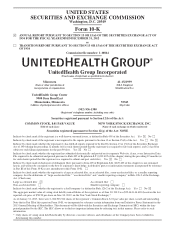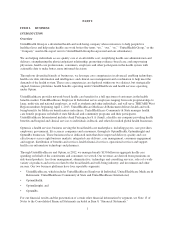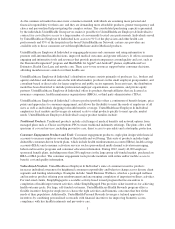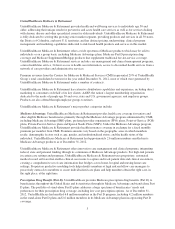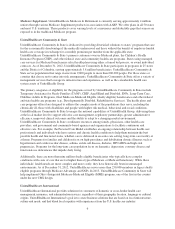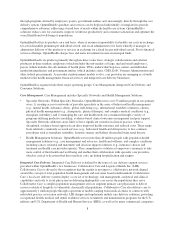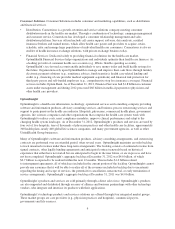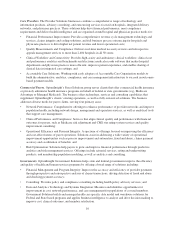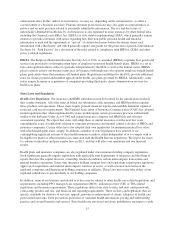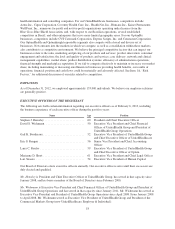United Healthcare 2012 Annual Report Download - page 10
Download and view the complete annual report
Please find page 10 of the 2012 United Healthcare annual report below. You can navigate through the pages in the report by either clicking on the pages listed below, or by using the keyword search tool below to find specific information within the annual report.through programs offered by employers, payers, government entities and, increasingly, directly through the care
delivery system. OptumHealth’s products and services can be deployed individually or integrated to provide
comprehensive solutions, addressing a broad base of needs within the health care system. OptumHealth’s
solutions reduce costs for customers, improve workforce productivity and consumer satisfaction and optimize the
overall health and well-being of populations.
OptumHealth offers its products on a risk basis, where it assumes responsibility for health care costs in exchange
for a fixed monthly premium per individual served, and on an administrative fee basis whereby it manages or
administers delivery of the products or services in exchange for a fixed fee per individual served. For its financial
services offerings, OptumHealth charges fees and earns investment income on managed funds.
OptumHealth sells its products primarily through its direct sales force, strategic collaborations and external
producers in three markets: employers (which includes the sub-markets of large, mid and small employers),
payers (which includes the sub-markets of health plans, TPAs, underwriter/stop-loss carriers and individual
market intermediaries) and government entities (which includes states, CMS, DoD, Veterans Administration and
other federal procurement). As provider reimbursement models evolve, care providers are emerging as a fourth
market for the health management, financial services and integrated care delivery businesses.
OptumHealth is organized into three major operating groups: Care Management, Integrated Care Delivery and
Consumer Solutions.
Care Management. Care Management includes Specialty Networks and Health Management Solutions.
• Specialty Networks: Within Specialty Networks, OptumHealth serves over 55 million people in two primary
ways: 1) creating access to networks of provider specialists in the areas of behavioral health management
(e.g., mental health, substance abuse), global well-being (e.g., international work/life solutions), chronic
physical health management (e.g., chiropractic, physical therapy), and complex medical conditions (e.g.,
transplant, infertility); and 2) managing the care and health needs for consumers through a variety of
programs utilizing predictive modeling, evidence-based clinical outcomes management and peer support.
Specialty Networks addresses areas likely to have significant variation in clinical practice, where a
disciplined, evidence-based approach can drive improved health outcomes and reduced costs. These range
from relatively commonly accessed services (e.g., behavioral health and chiropractic) to less common
procedures such as transplant, infertility, bariatric surgery and kidney disease/end stage renal disease.
• Health Management Solutions: OptumHealth serves more than 40 million people with population health
management solutions (e.g., care management and advocacy, health and wellness, and complex conditions
including cancer, neonatal and maternity) and decision support solutions (e.g., insurance choices and
treatment and health care provider options). This comprehensive solution set empowers consumers to take
more control of their health and well-being and enables their collaboration with specialty care providers,
which is critical to decisions that drive medical costs, including hospitalization and surgery.
Integrated Care Delivery. Integrated Care Delivery is defined by the types of care delivery support services
provided within OptumHealth’s two businesses: Collaborative Care and Logistics Health, Inc. (LHI).
Collaborative Care is driven by the recognition that the market is moving to a collaborative network aligned
around the concept of total population health management and outcomes based reimbursement. Collaborative
Care’s local care delivery systems deploy a core set of technology, risk management, analytical and clinical
capabilities and tools to assist physicians in delivering high-quality care across the populations they serve.
Collaborative Care’s complex population management services augment primary care physicians to deliver
services outside of hospitals to vulnerable, chronically ill populations. Collaborative Care also delivers care to
approximately 1 million people through a spectrum of models ranging from medical clinics to contracts with
individual practice association networks. LHI designs and implements mobile care delivery solutions, providing
occupational health, medical and dental readiness services, treatments and immunization programs for the U.S.
military and U.S. Department of Health and Human Services (HHS), as well as for many commercial companies.
8

